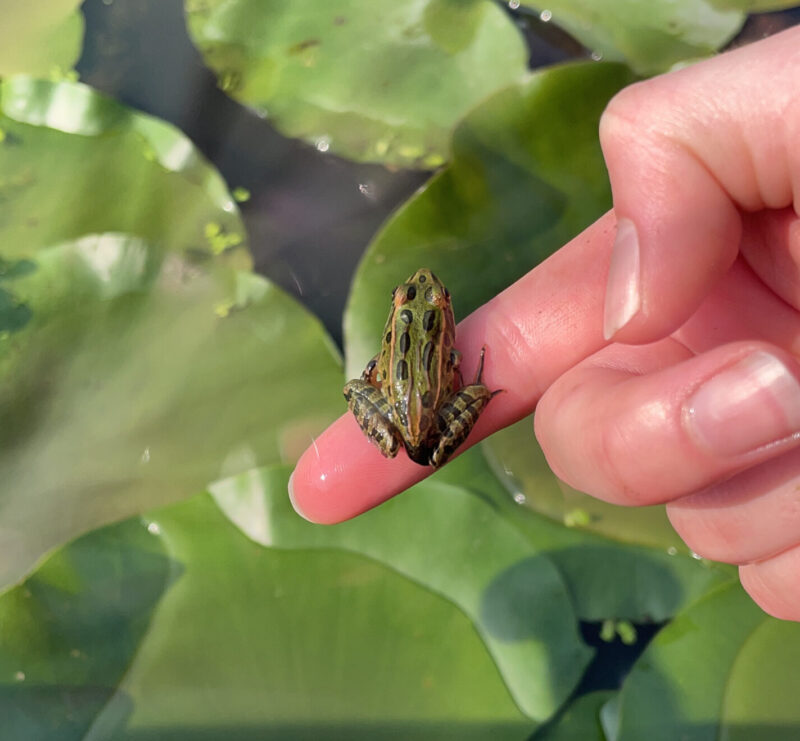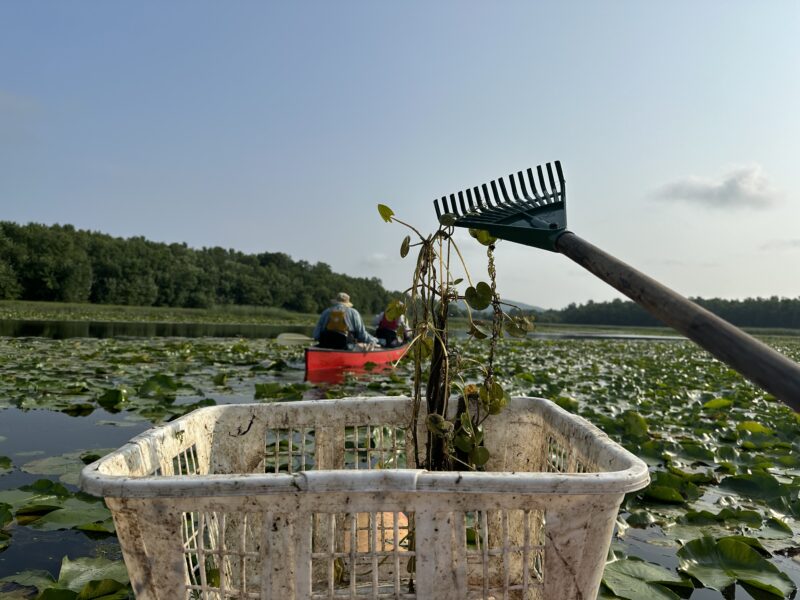Wrapping up the water quality stewardship field season
For yet another summer, volunteers of all ages hopped in kayaks and canoes to remove European frogbit, a non-native invasive plant species that spreads rapidly in bays and wetlands if given the opportunity.
In 2007, Lewis Creek Association initiated the “Water Quality Stewardship Program” and has since worked annually to manage the invasive plants and water quality of the rivers and streams that drain directly into Lake Champlain. The volunteer-driven frogbit project is the result of cooperation between many individuals and groups, including Lewis Creek Association, the towns of Charlotte, Shelburne and Hinesburg, Shelburne Bay Boat Club, and a supportive Charlotte property owner.
European frogbit, a common aquarium plant, spread to the United States via the St. Lawrence River after it was introduced to arboretum ponds in Ottawa in 1932.
It is now considered an aquatic invasive species because it dominates native species in the competition for sunlight, nutrients and surface area. Lewis Creek Association’s volunteer efforts have proven highly successful since friends of Lewis Creek Association discovered frogbit covering 50 percent of Town Farm Bay in 2007. Annual paddling and weeding trips, with a side of bird- and turtle-watching, have reduced the coverage of frogbit to just under 4 percent cover.

In contrast, when frogbit was discovered in the wetlands of the LaPlatte Natural Area, it had a much lower percentage cover; this gave Lewis Creek Association’s program and volunteers the opportunity for “early detection, rapid response.” Though the invasive plant will never be eradicated in either location, maintaining this low population allows native plants and animals to thrive.
This summer, volunteers spent 189 hours removing 600 pounds of frogbit from Town Farm Bay, nearly half the amount harvested in the summer of 2022. Volunteers spent nine hours harvesting 60 pounds of frogbit, twice the amount from last year, in the LaPlatte River wetlands. Overall, the presence of frogbit was significantly less than the previous summer.
Lots of rain throughout the month of July brought the Lake Champlain water level up, greatly increasing the amount harvested by volunteers. Frogbit became more visible to volunteers at both Town Farm Bay and the LaPlatte River wetlands because the higher water levels submerged the native lily pads (Nymphaea odorata), which cover much of the water surface area.
High water levels also allowed volunteers at the LaPlatte River wetlands to paddle into a previously inaccessible area to boaters. This area produced the majority of frogbit harvested at this location. Though water levels increased visibility and access to frogbit during July 2023, the overall poundage of frogbit harvested was around 40 percent less than the amount harvested last summer.
Lewis Creek Association’s Water Quality Stewardship Program also includes the annual monitoring of water quality in the LaPlatte River, Patrick Brook, McCabe’s Brook, Thorp Brook, Kimball Brook and Lewis Creek, by volunteers for South Chittenden River Watch. Volunteers collect water samples which are then analyzed by the Vermont Agricultural and Environmental Laboratory and interpreted by Lewis Creek Association technical consultants.

The sampling season has recently wrapped up and included sampling for nutrients (phosphorus, nitrogen) and chloride, in order to understand sources of nutrient loading to Lake Champlain while informing water quality improvement project plans. 2023 results will be available on Lewis Creek Association’s website in the spring of 2024; to see the last two years’ results. Check out more information on water quality and what you can do to improve it on Lewis Creek Association’s YouTube channel at bit.ly/LCA-youtube.
This water quality stewardship program is important for maintaining productive, functioning and scenic waters, and also allows residents of Charlotte, Shelburne and Hinesburg to become advocates for water quality. Volunteers in each town help share this information with neighbors and friends, helping improve water quality in the future.
This program being funded through your town budget is crucial, since it allows the whole community to take ownership of local water quality and natural resources that are extremely important to protect. This will result in healthier ecosystems that all citizens can enjoy. If you are interested in assisting with water quality monitoring or invasive plant removal in 2024, email Kate Kelly, Lewis Creek Association program manager or call 802-488-5203.

